Exploring the World of Iranian Spices: Varieties and Uses
- Ebrahim Bahrololoum
- No Comments
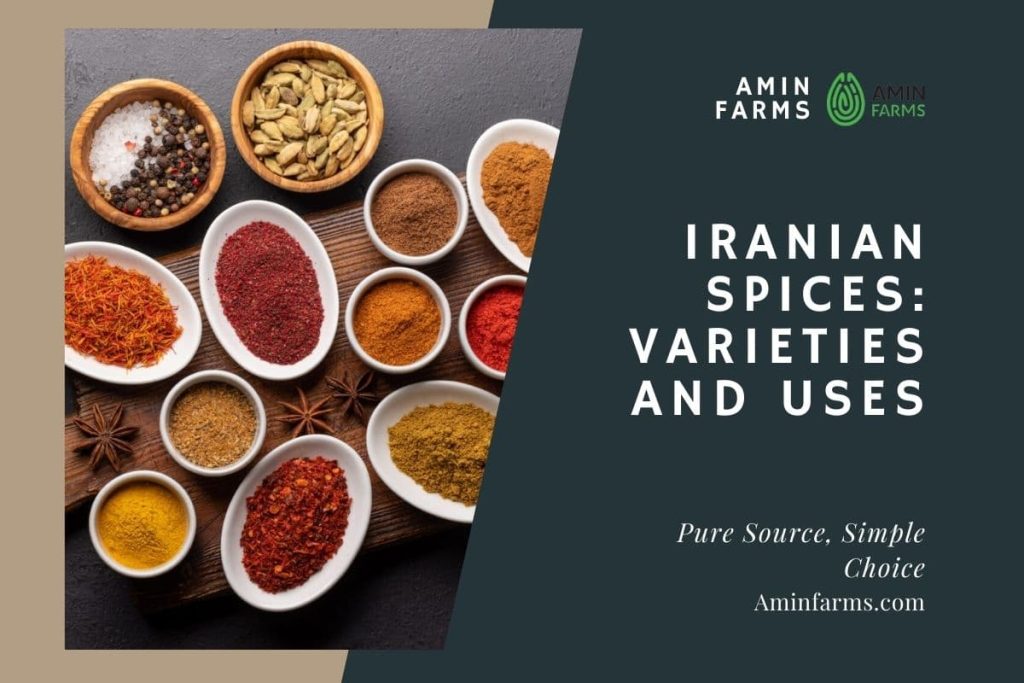
Iran is an ancient land and the heart of a deep and vibrant culture. Among its many treasures lies something truly special for the senses: Iranian spices.
These spices are not just flavorful ingredients used in cooking. They are woven into the country’s history, traditional medicine, and cultural heritage. From the brilliant color of saffron to the warm aroma of turmeric and the bold kick of chili peppers, each spice has its own unique story and purpose.
Iran’s diverse climate—ranging from fertile green mountains to vast arid deserts—creates ideal conditions for cultivating a wide array of aromatic and medicinal plants. This environmental richness has given rise to an incredible range of Iranian spice varieties, each adding its distinct flavor and fragrance to Persian cuisine.
This article invites you on a fascinating journey into the world of Iranian spices. We will explore their different types, historical roots, and many uses in cooking, traditional healing, and everyday life. If you are curious about this flavorful part of Iranian culture and would like to learn more, stay with us until the end of this article. You are about to step into a truly delicious experience.
Free Import & Export Consultation
The Rich Heritage of Iranian Spices
The history of spices in Iran goes back thousands of years and is deeply woven into the culture, medicine, and cuisine of the country. Archaeological discoveries show that ancient Iranians were familiar with the healing properties and flavor-enhancing power of herbs and spices from very early times. As the Silk Road crossed directly through Iran, it became a vital route for the exchange of spices between East and West, establishing Iran as a central hub in the growth and flourishing of the global spice trade.
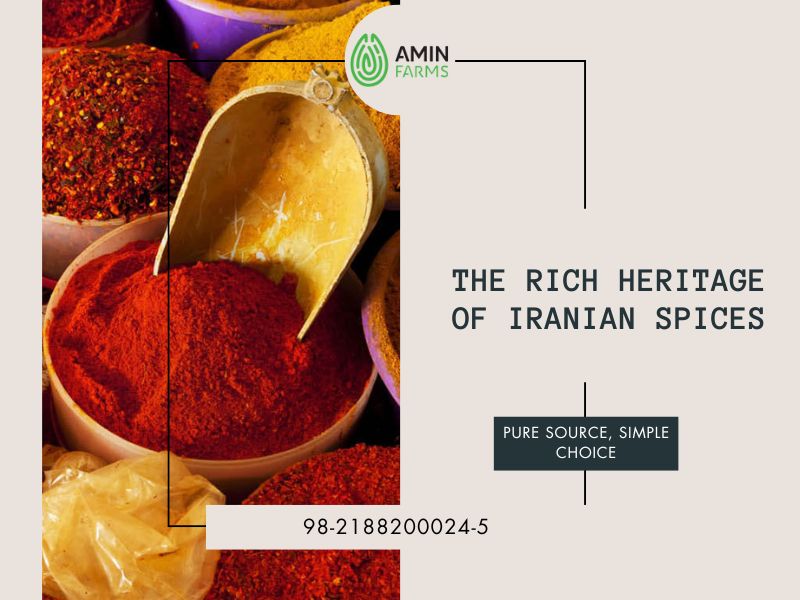 Historical writings and traditional Persian medical texts, such as those by Avicenna, are filled with references to the unique qualities of spices and their use in treating various illnesses. This knowledge has been passed down from generation to generation and remains a vital part of Iranian traditional medicine today. The uses of Persian spices go far beyond the kitchen. They have appeared in rituals, celebrations, proverbs, and even Persian poetry, showing their strong presence in the cultural heritage of Iran.
Historical writings and traditional Persian medical texts, such as those by Avicenna, are filled with references to the unique qualities of spices and their use in treating various illnesses. This knowledge has been passed down from generation to generation and remains a vital part of Iranian traditional medicine today. The uses of Persian spices go far beyond the kitchen. They have appeared in rituals, celebrations, proverbs, and even Persian poetry, showing their strong presence in the cultural heritage of Iran.
Iranian spices are more than just seasoning. They are symbols of ancient knowledge, natural healing, and the timeless art of a deeply rooted civilization.
Discover more: How to Import Saffron from Iran?
Iranian spices: A Legacy of Flavor
Iranian spices are at the heart of Persian cooking, giving dishes their unique flavor, color, and aroma. From aromatic rice dishes to flavorful stews and traditional desserts, spices shape the identity of Iranian cuisine. Saffron adds a golden color and delicate scent to meals like rice and shole zard. Turmeric is used in most stews, offering warmth and depth.
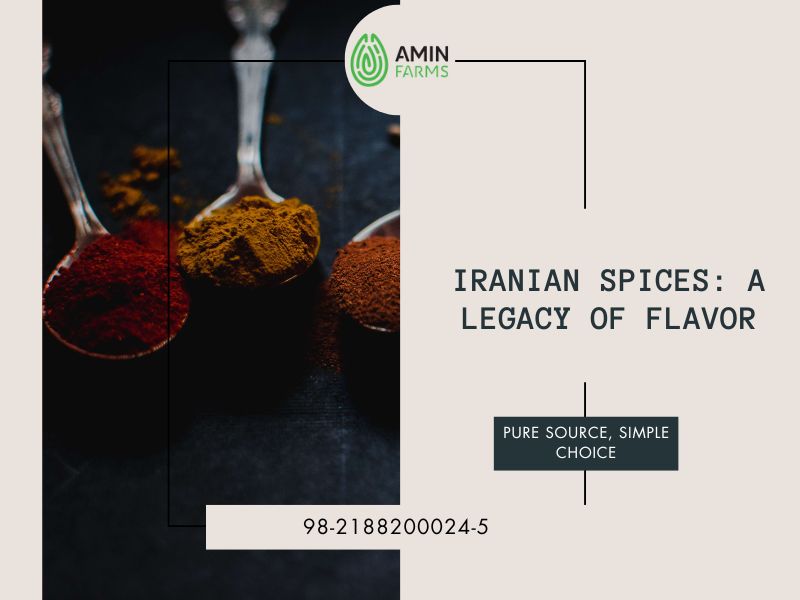 Cardamom and cinnamon bring sweetness and richness to desserts and drinks. The thoughtful use of Iranian spice varieties is what makes Persian food so distinctive and loved around the world. These spices are more than flavor; they are part of a cultural legacy that continues to delight taste buds across generations.
Cardamom and cinnamon bring sweetness and richness to desserts and drinks. The thoughtful use of Iranian spice varieties is what makes Persian food so distinctive and loved around the world. These spices are more than flavor; they are part of a cultural legacy that continues to delight taste buds across generations.
Saffron: The King of Spices
Among the rich variety of Iranian spices, saffron holds a truly special place. Often called the “king of spices,” it is treasured for its deep red threads, captivating aroma, and warm, slightly sweet flavor. Saffron gives dishes a beautiful golden color along with a distinct fragrance and depth that few other spices can match. Saffron comes from the dried stigmas of the Crocus sativus flower, and the delicate, time-consuming harvesting process is a significant reason for its high value.
Discover more: Exporting Spices from India
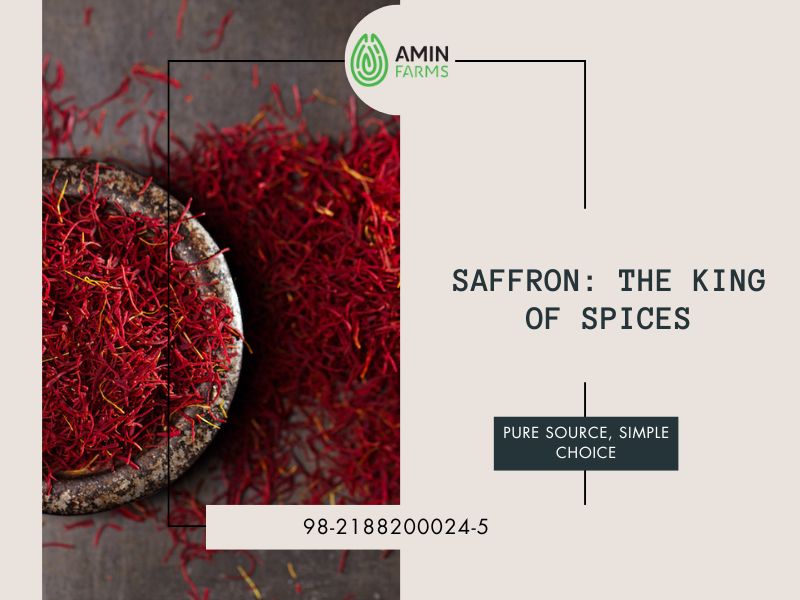 Iran is the world’s largest producer of saffron and the source of the finest quality. The unmatched excellence of Iranian saffron comes from the country’s unique climate, fertile soil, and the deep knowledge passed down through generations of farmers.
Iran is the world’s largest producer of saffron and the source of the finest quality. The unmatched excellence of Iranian saffron comes from the country’s unique climate, fertile soil, and the deep knowledge passed down through generations of farmers.
Saffron is more than just a flavor enhancer. It is a symbol of luxury, health, and authenticity. As one of the most cherished uses of Persian spices, saffron is an essential part of Iranian culinary tradition and cultural pride.
Turmeric and Cardamom: Hidden Gems
Alongside the elegance of saffron, the world of Iranian spices holds two other treasured ingredients that, while less globally known, are essential in Persian cooking and traditional healing: turmeric and cardamom.
Discover more: Import Cardamom from Iran
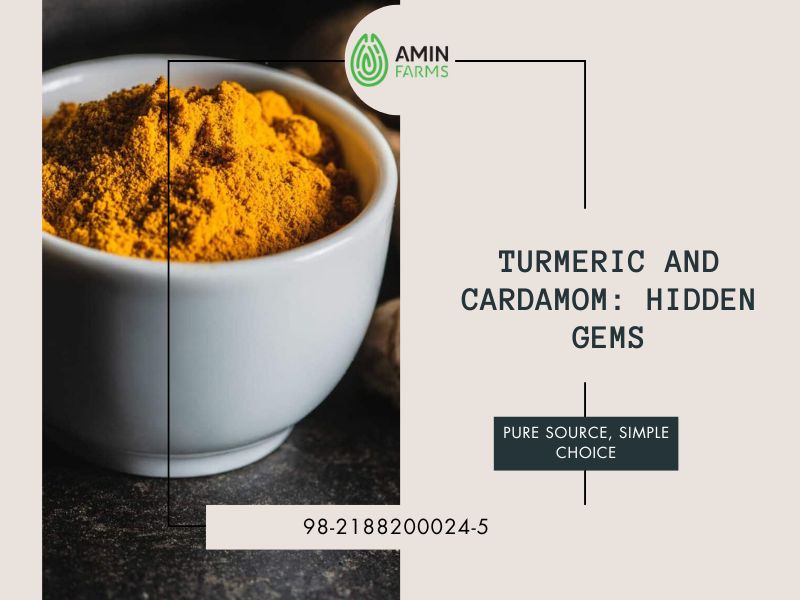 Turmeric, with its golden hue, is widely used in Iranian stews and dishes. It brings a warm, earthy flavor and a slightly spicy aroma. In traditional Persian medicine, it is valued for its anti-inflammatory and antioxidant properties and is often used as a natural remedy.
Turmeric, with its golden hue, is widely used in Iranian stews and dishes. It brings a warm, earthy flavor and a slightly spicy aroma. In traditional Persian medicine, it is valued for its anti-inflammatory and antioxidant properties and is often used as a natural remedy.
Cardamom, known for its sweet, spicy fragrance and superb taste, is a favorite in desserts, sweets, and Persian tea and coffee. These small, aromatic pods add depth to both flavor and scent. Like turmeric, cardamom is praised in traditional medicine for supporting digestion and boosting mood.
Together, turmeric and cardamom are shining examples of the everyday uses of Persian spices, blending flavor, health, and heritage in every Iranian kitchen.
Culinary Uses of Iranian Spices
Iranian spices are more than simple additions to food. They are essential elements that give Persian dishes their soul and character. The skillful use of these spices is the secret behind the rich flavors and enchanting aromas that make Iranian cuisine stand out around the world. Each spice plays a unique role in creating culinary masterpieces.
Discover more: Import Turmeric from Iran
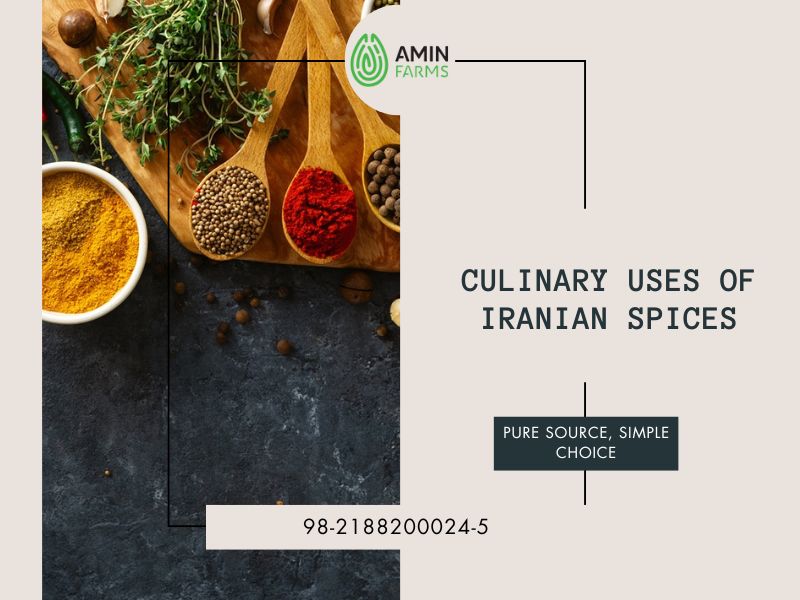 Saffron, with its golden color and delicate scent, is widely used in dishes like zereshk polo, baghali polo, shole zard, and many stews. Turmeric is a foundation in most stews and rice dishes, adding warmth and depth. Cardamom, with its sweet and spicy aroma, flavors tea, coffee, desserts like shole zard, and puddings.
Saffron, with its golden color and delicate scent, is widely used in dishes like zereshk polo, baghali polo, shole zard, and many stews. Turmeric is a foundation in most stews and rice dishes, adding warmth and depth. Cardamom, with its sweet and spicy aroma, flavors tea, coffee, desserts like shole zard, and puddings.
Cinnamon appears in haleem, shole zard, and some stews, while rosewater and cardamom give syrups and sweets their signature taste. Sumac is a key topping for kebabs, and black pepper adds heat and fragrance to many dishes. These thoughtful uses of Persian spices create unforgettable taste experiences for every palate.
Recipes from Iran and Beyond
 Persian cuisine is an art that reaches its full expression through the masterful use of spices. These ingredients are not just flavor enhancers. Each one plays a unique role in creating the color, aroma, and texture that define traditional Iranian dishes. Below are some of the most commonly used Iranian spices and their roles in cooking:
Persian cuisine is an art that reaches its full expression through the masterful use of spices. These ingredients are not just flavor enhancers. Each one plays a unique role in creating the color, aroma, and texture that define traditional Iranian dishes. Below are some of the most commonly used Iranian spices and their roles in cooking:
- Saffron: Known as the undisputed king of spices in Iran, saffron adds golden color and a unique fragrance to rice, shole zard, stews, and desserts.
- Turmeric: A golden spice that forms the base of many dishes, adding both color and a warm, earthy flavor.
- Cardamom: With its sweet and spicy aroma, cardamom is used in tea, coffee, sweets, and desserts like shole zard and ferni.
- Cinnamon: Adds warmth and sweetness to Haleem, shole zard, some stews, and traditional drinks.
- Sumac: A tangy red spice often sprinkled on kebabs and rice dishes.
- Black Pepper: Used to add heat and fragrance to stews, soups, and salads.
- Dried Rose Petals and Buds: Commonly used in jams, syrups, desserts, and food garnishing for their delicate aroma and taste.
Discover more: Import Pepper from Iran
Exporting Iranian Spices Globally
The export of Iranian spices, especially saffron, plays a vital role in the country’s economy and has positioned Iran as one of the key players in the global spice market. Iranian saffron, known for its exceptional quality, aroma, and flavor, is highly sought after worldwide. Countries like Spain, China, the United Arab Emirates, and various European nations are among the main buyers of this precious spice.
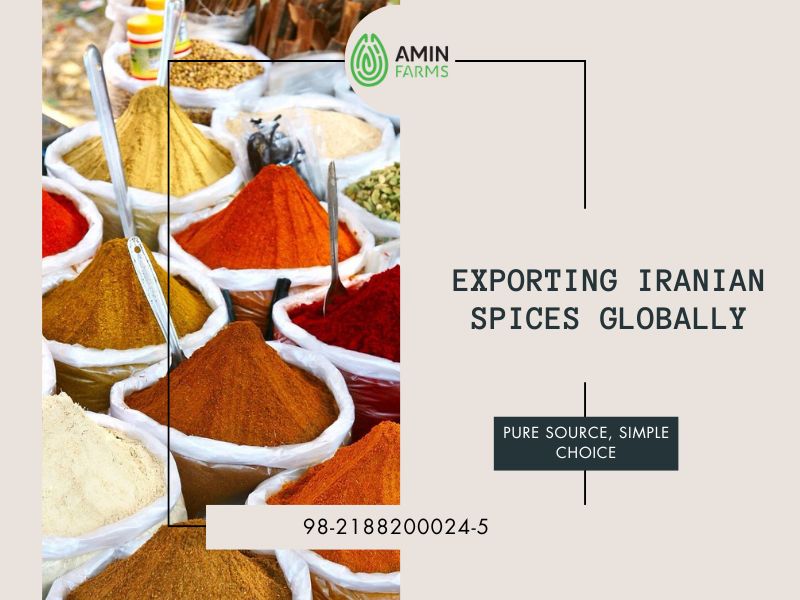 In addition to saffron, other Iranian spices varieties such as turmeric, cumin, sumac, and cardamom are also exported, though in smaller volumes. These exports not only bring valuable income to the country but also help introduce Iran’s rich culinary culture to the world.
In addition to saffron, other Iranian spices varieties such as turmeric, cumin, sumac, and cardamom are also exported, though in smaller volumes. These exports not only bring valuable income to the country but also help introduce Iran’s rich culinary culture to the world.
However, challenges such as international sanctions, currency fluctuations, and competition from other producers continue to impact the growth of this industry. Despite these hurdles, the heritage and quality of Iranian spices offer great potential for expanding their presence in global markets.
Discover more: Import Cinnamon from Iran
Why Choose iraninan Spices?
 Choosing the right spices can make a remarkable difference in the flavor and quality of your dishes. Our Iranian spices, especially those sourced from the heart of this ancient land, have unique qualities that set them apart from others. Here are some reasons why you should pick our spices for your kitchen:
Choosing the right spices can make a remarkable difference in the flavor and quality of your dishes. Our Iranian spices, especially those sourced from the heart of this ancient land, have unique qualities that set them apart from others. Here are some reasons why you should pick our spices for your kitchen:
- Unmatched Quality: Our spices come from the finest farms in Iran, where the climate and fertile soil guarantee top quality.
- Authentic Aroma and Flavor: Freshness and traditional harvesting methods give our spices a more pungent aroma and deeper taste, bringing the true essence of Iranian cooking to your table
- Health Benefits: Many Iranian spice varieties, like saffron and turmeric, not only enhance flavor but also offer proven medicinal benefits.
- Rich Heritage: By choosing our spices, you invite thousands of years of Iranian culture and culinary tradition into your home.
- Wide Variety: We offer a broad selection of both rare and popular Iranian spices to meet all your needs for authentic flavors.
With our spices, you don’t just add taste; you experience the rich culture and history of Iran in every grain.
Global Standing: Quantifying Iran’s Market Hegemony and Trade Dynamics
Iran holds an extraordinary position in the global spice world, driven by its unmatched dominance in saffron production. This leadership shapes market trends, influences prices, and highlights the spice’s cultural and economic significance. Understanding Iran’s role helps us appreciate the intricate balance of volume, quality, and global trade that keeps saffron flowing to tables around the world.
When we dive into how saffron reaches international markets, Iran’s story stands out as one of resilience, expertise, and strategic importance. It’s a testament to generations of knowledge that turns delicate threads into a global treasure.
Discover more: Exporting Cinnamon to Iran
The 85–90% Factor: Production Volume and Concentration Risk
At the heart of Iran’s global standing is its commanding share of saffron production, estimated at 85% to 90% of the world’s annual output. With total global production hovering between 450 and 500 tons each year, this means Iran contributes around 400 to 450 tons—making it the undisputed leader in volume.
This impressive output is largely concentrated in the Khorasan Razavi region, where ideal conditions foster expertise and efficient farming. However, this focus also introduces risks to the supply chain. As the source of nearly nine out of every ten kilograms of saffron traded worldwide, Iran effectively sets the bulk market prices. Any disruptions, from geopolitical issues to policy shifts or climate challenges like droughts, could ripple out, causing sharp price increases and shortages everywhere.
Recognizing this factor deepens our understanding of saffron’s global dynamics. It’s a reminder of how one region’s dedication supports an entire industry’s stability and flow.
Competitive Landscape and Iranian Comparative Advantage
Iran’s sheer volume sets it apart from competitors who focus more on niche, high-quality outputs. While these alternatives bring premium appeal, they lack the scale to sway global prices or supply.
Here are some key insights into the main players:
- Afghanistan: Holding 3–5% of the market, it’s gaining recognition for top-tier quality and emerging as a promising alternative.
- India (Kashmir Saffron): With about 2% share, this rare, GI-tagged variety is celebrated for its deep maroon threads and powerful aroma.
- Spain (Castilla-La Mancha): Contributing around 1%, its PDO-certified saffron emphasizes strict regional standards and premium branding.
- Greece (Kozani): Supplying less than 1%, this PDO-protected option is known for its subtle flavor and limited, high-end exports.
Competitors use geographic certifications to justify higher prices and provide backup options for buyers. Yet, Iran’s advantage lies in its massive supply and reliable coloring strength, making it essential for those needing consistent, large volumes. Buyers often blend Iranian saffron with these niches to balance risk and quality.
This landscape shows the beauty of diversity in saffron production. Iran’s role as the volume powerhouse ensures reliability, while others add layers of specialty, creating a richer global market.
| Country/Region | Estimated Global Market Share (%) | Key Production Characteristic | Competitive Strategy & Certification |
| Iran (Persian Saffron) | 85.0% – 90.0% | Highest Volume; Strong Coloring Strength; Global Export Leader | Volume & Price Anchor; Focus on ISO Purity (ISO 3632) |
| Afghanistan | 3.0% – 5.0% | Award-Winning Quality; Emerging Alternative Crop | Niche Market, Quality Competition, Focus on Purity |
| India (Kashmir Saffron) | ≈ 2.0% | Rare; GI-Tagged; Highly Aromatic, Deep Maroon Threads | Premium Niche, Regional Demand, Quality Control |
| Spain (La Mancha) | ≈ 1.0% | PDO-Certified (Protected Designation of Origin) | High-Value Branding, Controlled Terroir |
| Greece (Kozani) | < 1.0% | PDO-Certified; Delicate Flavor | Niche Export, Ultra-Premium Segment |
International Trade and Supply Chain Integrity
The global journey of Iranian saffron is multifaceted, with key markets like Saudi Arabia (7.59% of imports), the United Arab Emirates (7.45%), and the United States (7.12%) playing vital roles in absorption and distribution.
Countries such as the UAE and Saudi Arabia often serve as re-export centers, where saffron is processed or repackaged before heading to Western and other specialized markets. This setup navigates trade challenges and keeps Iranian saffron accessible worldwide, despite any hurdles.
That said, with demand sometimes outpacing the 450–500 tons of annual production and high prices tempting fraud, maintaining integrity is crucial. Adulteration risks challenge the industry, making strict adherence to standards like ISO 3632 essential for trust and quality.
Iran’s global standing thrives on this commitment to transparency. It’s what protects the Persian saffron legacy and ensures consumers everywhere enjoy the authentic, vibrant spice they deserve.








